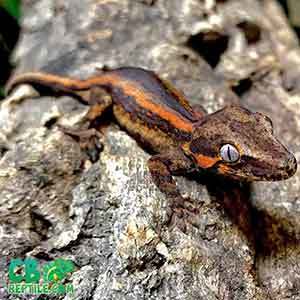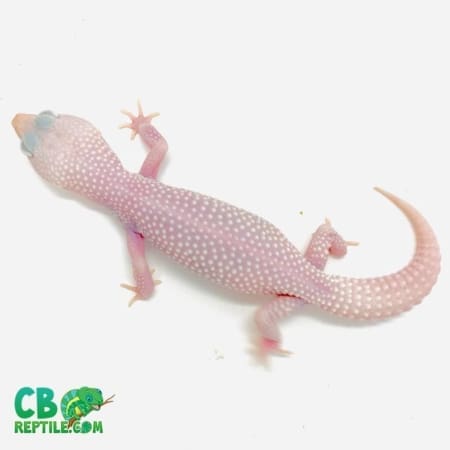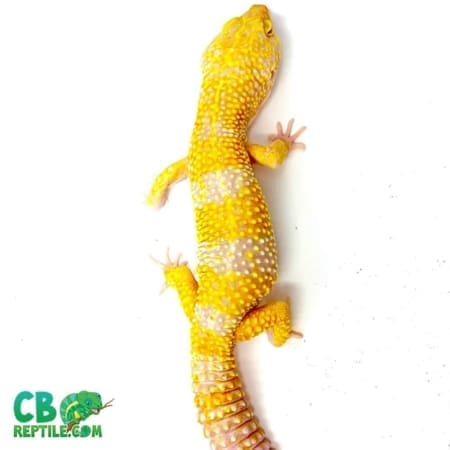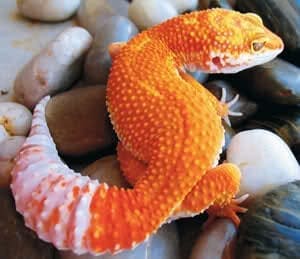Gargoyle Gecko Heating
Before purchasing your new gargoyle gecko for sale, find a reputable captive bred gargoyle gecko breeder and then get to set up your new Gargoyle gecko habitat! Gargoyle geckos really do not require much heating if anything. Heating is typically only needed to keep temperatures in the range of 70-74 degrees. For this reason, we recommend using a heat mat only if needed but only if you are using a reptile thermostat. Unlike leopard geckos for sale, both crested and Gargoyle geckos do not require a hot or cold spot even though they are cold blooded reptiles. If you are breeding your gargoyle geckos, it is recommended that you separate the males and females throughout the year. By doing this you can “cool down” your males which helps with breeding and fertility.
Step 2: Heating and Lighting
• Reptile habitat thermometers (2)
• Reptile habitat hygrometer
• Heat bulb and fixture
• Daytime fluorescent bulb, if necessary
• Lamp stand, if desired
• Ceramic heat emitter and fixture, or nighttime bulb, if necessary
• Timer for lighting and heating bulbs, if desired
Step 1: Choosing a gargoyle gecko terrarium
• 90 ltr (20-24″ tall) or larger vivarium
• Screen lid, if not included with habitat 
Step 3: Substrate and Decor
• Coconut fiber or bark
• Artificial/natural rock or wood hiding area
• Branches/plants for climbing and hiding
• Food and water dishes
Dietary Needs
• Commercially prepared diet designed for Crested Geckos
• Appropriate size live crickets
• Cricket food and cricket water gel
• Cricket keeper
• Calcium supplementation
• Spray bottle for misting
- Hatchling should be kept in a 23 ltr enclosure.
- Juvenile should be kept in a 45.5 ltr enclosure.
- Adult is comfortable in a 68-90 ltr enclosure.
Housing Harem
- Hatchlings of up to 5 should be kept in 45.5-68 ltr enclosure at minimum.
- Juvenile of up to 3 females should be kept in a 68 -90 ltr enclosure at minimum.
- Adults of a ratio of one male up to 5 females can be kept in a 136 ltr enclosure at minimum.
The nature of these geckos is quite aggressive and the housing of a harem can result in aggression of a dominant cagemate on all occupants of the cage and nipped, dropped or missing tails. The tails are generally eaten by the dominant cagemate. This aggression can begin at any stage of growth and if a regenerated tail is a concern then housing one individual gecko per cage is highly recommended. You may limit the aggression by allowing enough cage space for the pursued gecko to escape and multiple hiding places. An observed cagemate exhibiting aggression can be removed and housed solo. An ample supply of food at all times is also recommended.
This species is temperature sensetive and should never be exposed to temperatures above 29°C or near a window where the temperature fluctuates. Be smart about providing heat and make sure you use a temperature regulating device.
Temperature, Humidity & Lighting
Gargoyle Geckos come from a more arid habitat on Grande Terre but fit in well with the same regimen as that used with their counterparts in the genus. A temperature range of 21°C to 27°C is adequate. A basking spot of 27°C-28°C may be used if provided, especially during breeding season. Do not allow the temperature to rise above 27°C or fall below 19°C as these temperatures may result in death.
Humidity is an important factor in the overall health of your Gargoyle Gecko. Proper humidity should reside in the 60-80% range. Inadequate humidity will result in shedding problems. Poor shed can have severe health problems such as lost limbs (digits) to decreased eye sight and even death. For areas that have relatively low humidity you can mist the enclosure as many times as necessary or introduce a waterfall or potted plants. For the extreme such as a desert climate you can provide a humidifier in the room the Gargoyle Gecko is in or a humidifier specifically for the enclosure that turns on periodically or from a sensor.
Too much humidity can also be a bad thing. Standing puddles of water can provide sanctuary for bacteria to live. Gargoyle Geckos should not be exposed to damp conditions for long periods of the day. Routine cleaning and exposure to UVA/UVB can reduce the risk of harmful bacteria. A humidity cycle is also recommended. Allow the enclosure to dry out for a period during the day. This will limit the ability of bacteria to thrive.
Lighting has been highly debated. All Rhacodactylus geckos spend some time exposed to daylight in nature but the benefits are skeptical at best. We know that full spectrum lighting will help prevent bacteria growth. We also know that the hours of lighting will help induce breeding in most reptile species. We follow daylight savings time in our facility. 12-14 hours of daylight during the summer months and 10 hours of light during the winter months. We do not provide UVB/UVA but offer food items that contain calcium and vitamin D3.
Diet & Nutrition
Gargoyle Geckos feed on insects, smaller lizards, pinkie mice, fruit and nectar in the wild. Their natural habitat should be full of potential prey items and from a young age all insects slightly larger than the space between the eyes are relished. As these geckos mature to become adults they become less interested in the conventional insects. Larger prey items such as newly born pinkie mice, and feeder roaches are recommended.
Meal Replacement Powder
We have found Crested Gecko Diet from Repashy Superfoods to be the most nutritionally balanced diet available. There are two forms of the diet. The most common is the Complete diet which is formulated to be able to provide all the nutritional needs of these geckos by simply mixing the powder with water. The second is a Two Part Gecko MRP system developed for the hobbyist to select what flavors to offer your geckos for an increased feeding response from the pickiest of geckos. With the Two Part Gecko MRP system you will select your flavor and mix it with the base by weight using a food scale for the desired result.
Live Feeders
Gargoyle Geckos will readily feed on live insects from hatchling to juvenile. Offer a robust prey item and no more than 5 insects per feeding. As they mature to adult you may want to offer feeder roaches or pinkie mice to familiarize the gecko with other available food items. Eventually they will loose interest in crickets and other live feeders will be needed to sustain breeding.
Dust all live feeders with a Vitamin and Mineral supplement mixed with Calcium that has D3. D3 is required for nocturnal species that do not utilize UVA/UVB lighting to properly digest and utilize Calcium. Without D3, any reptile will suffer and eventually die from Metabolic Bone Disease. We use and recommend CalciumPlus by Repashy Superfoods and ReptiCalcium by ZooMed.
For Gargoyle Geckos choose a feeders by size in length. The size should not be much greater than the length between the eyes and very robust. Coat the feeder using Calcium with Vitamin D3 by placing the feeder in a plastic bag with the powder and shaking until the feeder is coated in the supplement.
Weekly Feeding Routine
We follow the same feeding routine as with all our geckos. We offer fresh Crested Gecko Diet three times a week; Monday, Wednesday and Friday. We allow the food to stay in the enclosure until we replace it on that third night. We find that as the diet becomes ripe the geckos tend to consume more of it. In nature a piece of fruit that falls to the ground and begins to ripen (not spoil) allows for the geckos to be more apt to smell, find and consume the fruit. On Sunday we remove all food from the enclosure and offer live prey that has been dusted with vitamins and minerals and gut loaded the night before. Any mixed but not served diet is placed in the refrigerator or freezer for future feeding.
From time to time, during breeding season, we attempt to switch up the feeding of live prey and the CGD. Rather than feed live prey once a week we may try to feed again on a second night during the week rather than the Crested Gecko Diet. We shoot for Wednesday and Sunday for live feeders but if no live feeders are accepted we offer the CGD the following day or that evening.
Handling & Taming
Much like Crested Geckos, Gargoyle Geckos tolerate a good amount of handling. Care should be given to new additions or untamed animals. Always allow a 2 week period where handling is avoided. Hatchlings especially should be observed and if handling becomes necessary bring the cage to the ground level and handle the gecko just barely off the ground. This two week period will allow the animal to become accustomed to your interaction and routine limiting undue stress.
Handling your new gecko will help tame them. We recommend handling each day after the two week waiting period of about 5 minutes or more. This will help the gecko become accustomed to you by sight and scent. After the first few weeks and depending on the behavior of the gecko you can increase the handling time of up to 20 minutes.
We recommend a handling technique referred to as “hand walking”. While the gecko is on one hand and alert they will attempt to jump, climb or move from one hand to the next. With the gecko in either your left or right hand place your free hand in front of the gecko. A distance away will entice the gecko to jump while a hand in hand posture will result in climbing. With the gecko moving from one hand to the next continue placing the free hand in front. This is also very good exercise and a bonding experience between the gecko and handler essentially taming the pet. Remember to do this process low to the ground to prevent injury from falling. Young Gargoyle Geckos should not be placed in a position to jump especially over a hard surface. Keep your hands close while using this technique.
Sexing
Sexing Gargoyle Geckos can be performed as soon as the Snout to Vent Length reaches 2.7-3″. Females exhibit pseudopores (similar scale shape as the male pores) that form in rows of three compared to the males five rows of preanal pores. Another way to distinguish between the male and female is that the male will have enlarged cloacal spurs and a postanal hemipenile bulge. Females can present a similar postanal bulge, but not as large. The best way to determine sex is with a photographer or jewelers loupe and count the rows of pores.
Breeding
Breeding Gargoyle Geckos requires patience and greater attention than the breeding of Crested Geckos. As stated previously these geckos can exhibit aggression towards one another (often females toward the male) which can result in limited eating habits, tail loss and wounds from bites. With all that said a watchful eye is recommended to ensure breeding success.
Stress is a big factor to consider when planning a breeding project. The breeding cage should be setup first and of appropriate size with a good amount of thick branches and foliage to escape an aggressor. Do not disturb the cage except to clean and be sure to keep the breeders in the same cage throughout the season. A lay box with appropriate substrate material should be incorporated into the enclosure before the breeders are introduced. The lay box serves other purposes than depositing eggs such as shedding and refuge from tankmates.
- Sexual maturity is reached in 12-18 months and at the least weighing 40 grams.
- 4-5 clutches of 2 eggs are laid per year with a 4-6 week break between laying.
Incubation
We only recommend calcined clay (SuperHatch) as an incubation medium. Temperatures should be regulated between 22°C and 28°C . The greater the incubation temperature the shorter the incubation time (between 45-60 days), and lower the incubation temperature the longer the duration (between 60-70 days).
- Temperature Sex Determination is effective with this species.
- Temperatures in the low 20°C produce mostly females
- Temperatures in the high 20°C produce mix of male and female
- Temperatures slightly above 27 °F produce mostly males
- care can differ for a baby Gargoyle gecko vs adult Gargoyle geckos for sale
Juvenile Care
We house single hatchlings in a medium Kritter Keeper until they reach 10 grams in weight and at that point move them into 45 ltr enclosures up until adult size. I keep the same feeding schedule for Hatchlings as I do Adults with the only difference being the amount of food offered is slightly less. We house them on their own to prevent tail loss. If housed in groups you will want to keep the sizes very close and remove larger individuals or faster-growing individuals from the group. Separation should be done prior to sexual maturity and males housed separate from females but similar sized females can mature together if time is available to observe their habits and potential injury or lost tails
-

black night leopard gecko
$949.00 – $1,695.00 Sale!Select options This product has multiple variants. The options may be chosen on the product page -

Striped Emerine Leopard gecko
$299.95 – $849.00 Sale!Select options This product has multiple variants. The options may be chosen on the product page -
 Rated 5.00 out of 5
Rated 5.00 out of 5Diablo Blanco Leopard gecko for sale
$169.95 – $759.00 Sale!Select options This product has multiple variants. The options may be chosen on the product page -

Tangerine Albino supergiant leopard gecko
$269.95 – $749.00 Sale!Select options This product has multiple variants. The options may be chosen on the product page -
 Rated 5.00 out of 5
Rated 5.00 out of 5Tangerine Super Giant Leopard gecko
$299.95 – $695.00 Sale!Select options This product has multiple variants. The options may be chosen on the product page -

Tangelo leopard gecko
$179.00 – $689.00 Sale!Select options This product has multiple variants. The options may be chosen on the product page -

Blood het Tremper Albino Leopard gecko
$199.95 – $649.00 Sale!Select options This product has multiple variants. The options may be chosen on the product page -

Tangerine Albino leopard gecko
$169.00 – $599.00 Sale!Select options This product has multiple variants. The options may be chosen on the product page -

Aptor Leopard gecko
$149.95 – $599.00 Sale!Select options This product has multiple variants. The options may be chosen on the product page -

Blood leopard gecko
$199.00 – $599.00 Sale!Select options This product has multiple variants. The options may be chosen on the product page -

blood supergiant leopard gecko
$269.95 – $599.00 Sale!Select options This product has multiple variants. The options may be chosen on the product page -

Firewater Blood cross Leopard gecko
$159.95 – $599.00 Sale!Select options This product has multiple variants. The options may be chosen on the product page -

Firewater Leopard gecko
$179.95 – $599.00 Sale!Select options This product has multiple variants. The options may be chosen on the product page -

blood purple head leopard gecko
$169.00 – $589.00 Sale!Select options This product has multiple variants. The options may be chosen on the product page -

Bold Super Giant Leopard gecko
$259.95 – $569.00 Sale!Select options This product has multiple variants. The options may be chosen on the product page -

Blazing Blizzard Leopard gecko
$169.00 – $549.00 Sale!Select options This product has multiple variants. The options may be chosen on the product page -
 Rated 4.88 out of 5
Rated 4.88 out of 5Mack Super Snow Leopard gecko for sale
$169.00 – $549.00 Sale!Select options This product has multiple variants. The options may be chosen on the product page -
 Rated 5.00 out of 5
Rated 5.00 out of 5Mandarin Tangerine Leopard gecko
$199.00 – $499.00 Sale!Select options This product has multiple variants. The options may be chosen on the product page -

Electric Tangerine Leopard gecko
$189.95 – $499.00 Sale!Select options This product has multiple variants. The options may be chosen on the product page -
 Rated 5.00 out of 5
Rated 5.00 out of 5Bold Leopard gecko for sale
$149.95 – $499.00 Sale!Select options This product has multiple variants. The options may be chosen on the product page





























